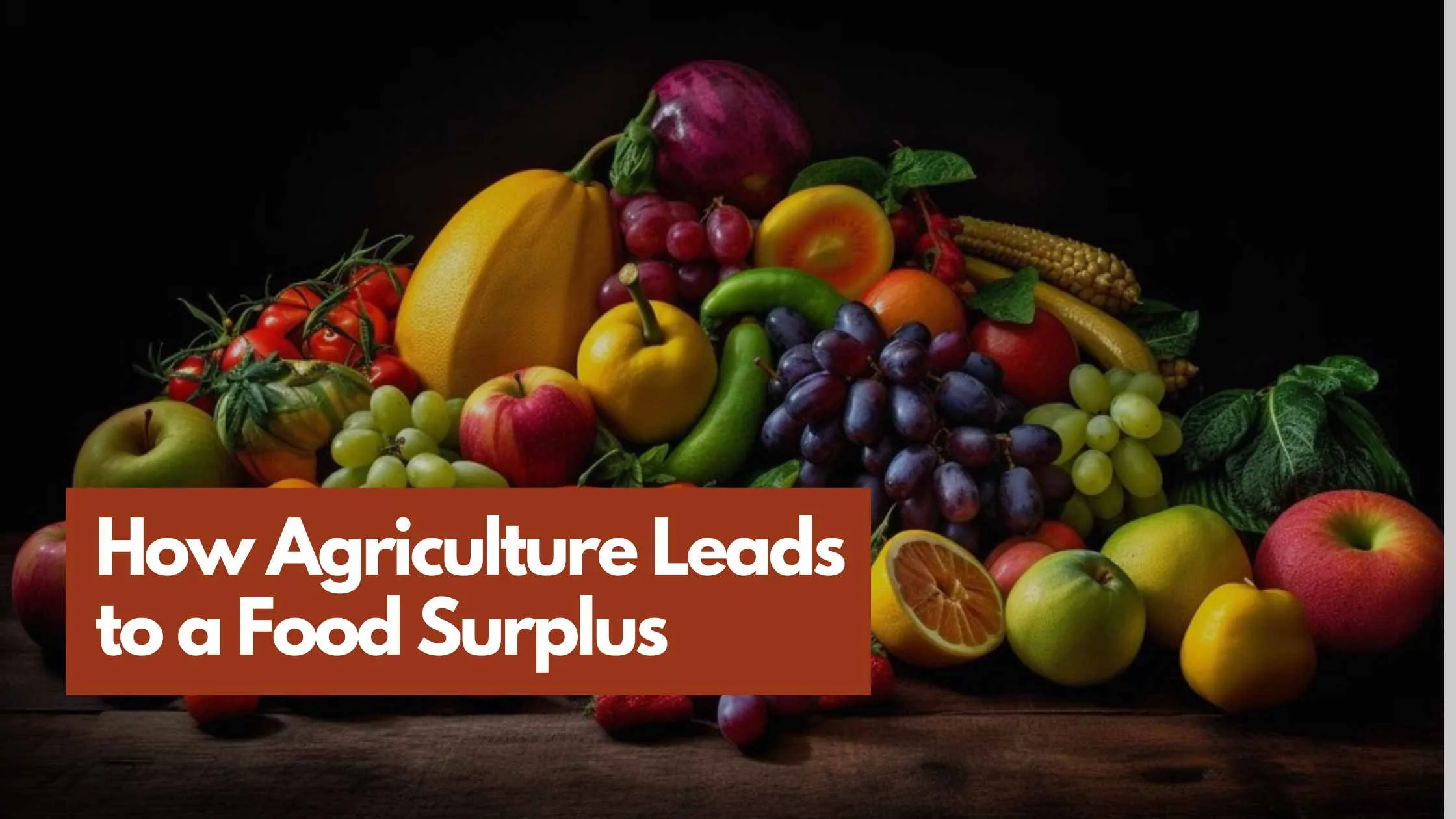What is a food surplus?
Food surplus refers to the amount of food that remains available after meeting the needs of the population. It occurs when the amount of food produced exceeds the amount required to feed the population. It can also occur at various levels, from the household level to the national level, and can result from various factors such as improved agricultural practices, efficient distribution systems, and reduced waste.
Surplus food can be stored for future use or exported to other regions or countries. However, despite the existence of food, many people around the world still suffer from hunger and malnutrition due to factors such as poverty, inequality, and inadequate access to food distribution systems.
Food surplus examples
There are several examples of food surplus, including:
Farmer’s market surplus
Farmer’s markets often sell locally grown produce, and if there is a surplus of fruits and vegetables, they may sell them at a discounted rate or donate them to food banks or charities.
Supermarket surplus
Supermarkets may have a surplus of products that are close to their expiration date, which they can sell at a discounted price or donate to food banks.
Restaurant surplus
Restaurants may have a surplus of food at the end of the day, which they can donate to food banks or charities.
Agricultural surplus
Agricultural surplus refers to the excess of crops produced beyond the needs of the population. These surpluses can be stored for future use or exported to other regions or countries.
Government surplus
Governments may have a surplus of food that they can distribute to those in need, such as disaster victims or low-income families.
It’s important to note that while a food surplus exists, it doesn’t necessarily mean that everyone has access to food. Many people around the world still suffer from hunger and malnutrition due to poverty, inequality, and inadequate access to food distribution systems.
Why is a food surplus important?
Food surplus is important for several reasons:
- Food security: Surplus food can help to ensure food security by providing a buffer against food shortages and price spikes. In times of food scarcity or natural disasters, having a surplus of food can help to ensure that everyone has access to enough food.
- Economic benefits: Surplus food can be sold or exported, generating income for farmers, businesses, and countries. This can help boost economic growth and stability.
- Reduced food waste: Food can help reduce food waste by ensuring that excess food is used rather than thrown away. This is important because food waste is a major contributor to greenhouse gas emissions and can have negative environmental impacts.
- Food aid: Surplus food can be donated to food banks or distributed to those in need, such as low-income families, disaster victims, and refugees. This can help to alleviate hunger and malnutrition.
Overall, food is important because it can help to ensure food security, generate economic benefits, reduce food waste, and provide food aid to those in need.
However, it’s important to remember that food is not a solution to food insecurity and malnutrition on its own. Addressing poverty, inequality, and inadequate access to food distribution systems is also essential for ensuring that everyone has access to enough food.
What is surplus farming?
It refers to the practice of producing more food than is needed to meet the immediate needs of a population. This can be done intentionally or unintentionally and can result in excess food that can be stored, sold, or donated.
Surplus farming can be beneficial in several ways. It can provide a buffer against food shortages and price spikes, ensuring food security for the population. Farming can also generate income for farmers and communities by selling excess produce, boosting economic growth and stability.
Additionally, surplus farming can help reduce food waste by using the excess food rather than throwing it away.
However, surplus farming can also have negative consequences. Overproduction of food can lead to environmental degradation, such as soil erosion, deforestation, and water pollution. It can also contribute to the overuse of pesticides and fertilizers, which can harm the environment and human health.
To ensure sustainable surplus farming, it’s important to use environmentally friendly farming practices, manage resources responsibly, and avoid overproduction that could result in waste or negative environmental impacts.
Surplus food: modern-day examples
There are several modern-day examples of surplus food:
Food banks and food rescue organizations
These organizations collect food from supermarkets, restaurants, and other sources and distribute it to people in need.
Gleaning programs
It is the practice of harvesting crops from farms after the main harvest. These programs allow volunteers to gather fruits and vegetables that would otherwise go to waste.
Farm-to-school programs
Farm-to-school programs connect local farmers with schools, providing surplus produce to school cafeterias for meals and snacks.
Community-supported agriculture (CSA)
CSA programs allow people to buy a share of a local farm’s produce, often resulting in produce that can be distributed or donated.
Food recovery programs
These programs collect surplus food from events such as weddings, conferences, and catered events and donate it to people in need.
The examples show that there are many ways to use food to benefit people and communities, whether it’s by reducing food waste, supporting local agriculture, or providing food to those in need.
However, it’s important to remember that food alone cannot solve the problems of food insecurity and malnutrition. Addressing poverty, inequality, and inadequate access to food distribution systems is also essential for ensuring that everyone has access to enough food.
How Agriculture Leads to a Surplus of Food
Agriculture can lead to a surplus of food in several ways:
Increased productivity
Advances in agricultural technology and practices, such as improved irrigation systems, the use of fertilizers and pesticides, and selective breeding of crops and livestock, have increased the productivity of agriculture, allowing farmers to produce more food with the same amount of land and resources.
Expansion of cultivated land
As the world’s population grows, there is a greater demand for food. This has led to the expansion of cultivated land, which has increased the overall amount of food produced.
Efficient distribution systems
Advances in transportation and storage technologies have improved the efficiency of food distribution systems, allowing surplus food to be transported and stored for future use.
Reduced waste
As mentioned before, food can be donated or sold at a discounted rate rather than being thrown away, reducing food waste.
Overall, agriculture leads to a surplus of food by increasing productivity, expanding cultivated land, improving distribution systems, and reducing waste. However, it’s important to remember that food surplus alone is not enough to ensure that everyone has access to enough food. Addressing poverty, inequality, and inadequate access to food distribution systems is also essential for ensuring food security and reducing malnutrition.
How did food surpluses lead to the development of civilizations?
Food played a critical role in the development of civilizations by allowing for the growth of populations, the development of trade, and the establishment of social and political structures.
With a surplus of food, populations could grow beyond the level that subsistence farming could support. This led to the development of larger settlements and eventually to the development of cities. These cities became centers of trade and commerce where people could exchange goods and services, including surplus food.
The development of trade and commerce, in turn, led to the establishment of social and political structures. As cities grew and trade became more complex, leaders emerged to manage the affairs of the community. These leaders, in turn, developed systems of and law to ensure the smooth operation of society.
In addition, surplus food allowed for the development of specialized occupations beyond farming, such as artisans, craftsmen, and merchants. This allowed for the development of culture, art, and science, which in turn contributed to the development of civilization.
Overall, food was a critical factor in the development of civilizations by allowing for population growth, the development of trade and commerce, and the establishment of social and political structures.
Conclusion
In conclusion, food surpluses have played a crucial role in the development of human civilization. Surplus food has allowed for the growth of populations, the development of trade and commerce, and the establishment of social and political structures. With food, societies could grow beyond subsistence farming and establish larger settlements and cities that became centers of trade and commerce.
The development of specialized occupations beyond farming, such as artisans and merchants, also allowed for the growth of culture, art, and science. While food surpluses alone cannot guarantee the development of civilization, they are a necessary condition for it to occur, and their importance cannot be overstated.




Fascinating read! Your blog brilliantly highlights how agriculture’s efficiency creates a bountiful surplus. It’s incredible to see the intricate dance of nature and human ingenuity, ensuring food abundance. From field to table, the journey is truly captivating.
Thanks a bunch for the kind words! So glad you found the journey from field to table captivating. It’s indeed a mesmerizing dance of nature and human ingenuity. Here’s to the magic of agriculture that brings us the bountiful food surplus! Your appreciation fuels the passion behind sharing these stories. Stay tuned for more agri-adventures!
Mind blown by this post on how agriculture creates a food surplus! It’s like uncovering the magic behind our bountiful harvests.
Reading about how agriculture leads to a food surplus is like discovering the secret sauce of abundance. Who knew farming had such fascinating insights!
Finished reading about agriculture and food surplus, and I’m impressed by the ingenuity behind it all. Cheers to sustainable farming practices!
Absolutely! Sustainable farming practices truly deserve a round of applause. It’s incredible to see how innovation in agriculture has not only increased food production but also prioritized the long-term health of our planet. Cheers to farmers and agricultural experts who are leading the way in implementing sustainable methods that benefit both people and the environment. Let’s continue to support and advocate for practices that ensure a bountiful harvest for generations to come!
It’s such an enlightening post! It’s fascinating to learn about the mechanisms behind food surplus and how agriculture plays a crucial role.